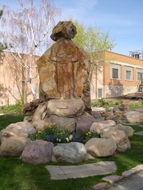
Home » Journal Articles » Thoughts & Opinions » Salt Lake City’s Gilgal Garden
When I think of the best visionary or folk art installations in the western United States, three come to mind: Grandma’s Bottle Village in Simi Valley, California; the Rodia Watts Towers in Los Angeles; and Gilgal Garden in Salt Lake City, Utah. As a stone carver and a resident of Salt Lake, Gilgal stands out for me. And, it’s worth a trek from the Northwest for any sculptor, art lover, philosophy student, mason, Mormon or curiosity seeker.
Located next to the Wonder Bread Bakery in the heart of Salt Lake City, Gilgal Garden is a spectacle of stone sculpture. A pink stone sphinx with the head of Joseph Smith, founder of the LDS church, greets you upon entering the garden. The dream of King Nebuchadnezzar is illustrated with the body of a giant blown apart and strewn on a knoll: the head here, a foot there, the torso over there. Two stone human hearts sit in a hand-hewn alcove. A larger than life self-portrait of the garden’s creator, Thomas Child, is standing in a shrine to the craft of masonry. And, he’s wearing brick pants.
Child, a successful masonry contractor, began creating Gilgal Garden in 1945 when he was 57 years old. He wanted to give physical form to his deep-felt beliefs. He wrote: “Can I create a sanctuary or atmosphere in my yard that will shut out fear and keep one’s mind young and alert to the last, no matter how perilous the times?” A tall order. Yet, by his death in 1963, Thomas Child had created 13 sculpture arrangements and over 70 engraved stones that gave form to his vision. Twelve of the sculpture groupings are within Gilgal Garden, now a Salt Lake City park. And, though some pieces have suffered vandalism over the decades, they remain a strong confirmation of Child’s creativity.

Gilgal is a term taken from the Bible meaning circle of sacred stones. The major sculpture groups illustrate stories from the Bible and make statements about Child’s strongly-held beliefs, much of them Mormon. He further illuminated his philosophy by populating his garden with engraved flat stones featuring hymn lyrics, poems and quotations such as:

“After me cometh a builder. Tell him, I too have known. This place is sacred to all, seeming thick set with laurel, olive, vine; and in its heart a feathered choir of nightingales makes music. So sit thee here on this unhewn stone.”
Child traveled across Utah in search of the massive stones for his sculptures – usually freeform boulders weighing up to 62 tons. He looked for “a boulder in which I could put over the idea and tell the story and still have it a stone.” In conjunction with his son-in-law, Bryant Higgs, Child developed the artistic use of the oxyacetylene torch for cutting and sketching the stone. The torch removed rock to reveal the sculpture and melted or fused its surface to develop a hard polished sheen that has survived decades of Utah’s winter’s freeze-thaw cycle and summer’s high temperatures.
All the sculptures were created on site. Child worked closely with artists and craftsmen to build the sculptures. He commissioned Maurice Edmund Brooks, a local sculptor, for the sculptures that included human forms. Higgs taught Brooks how to use the torch. Child closely supervised his work on several pieces including
The Sphinx and The Monument to the Trade.
Child opened his garden to visitors from around the world. After his death in 1963, the grounds became a haven for stoners and vision-seekers of the 1960s and 70s. As writer Terry Tempest Williams recalls: “My friends and I only knew this as a place of mystery in a culture that seemed to have most of the answers. This was a place that encouraged creativity in a town that to us embraced Wonder Bread. This was a place where we could try new ideas and scare ourselves with possibilities. We could be different. We were wild minds on the edge of wild country. Gilgal let us stare at the question mark engraved in granite.”
Some of these kids would grow up to form an eclectic coalition of people that called themselves Friends of Gilgal Garden. Their efforts saved the garden from developers, successfully making it a city park. Working with many organizations, The Friends have restored some of the sculptures, the workshop, and landscaping. And, they have ensured the viability of Gilgal Garden for generations to come.
It is the humble recognition of the challenge of art and craft that endears Child and his wonderful sculpture garden to me. Gilgal Garden is a moving, meditative experience. I may not agree with many of the statements he has torched into stone, but I deeply respect his ability to execute his vision so eloquently.









We need some kind of descriptive text here.